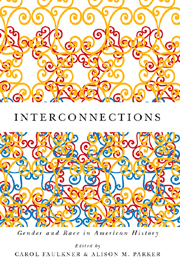Book contents
- Frontmatter
- Contents
- Introduction
- Part 1 Bridging History, Theory, and Practice
- Part 2 Frontiers of Citizenship
- 2 “Laissez les bons temps rouler!” and Other Concealments: Households, Taverns, and Irregular Intimacies in Antebellum New Orleans
- 3 “There Are Two Great Oceans”: The Slavery Metaphor in the Antebellum Women's Rights Discourse as Redescription of Race and Gender
- 4 “Grandpa Brown Didn't Have No Land”: Race, Gender, and an Intruder of Color in Indian Territory
- Part 3 Civil Rights and the Law
- Part 4 Sexuality, Class, and Morality
- Epilogue: Gender and Race as Cultural Barriers to Black Women in Politics
- Selected Bibliography
- List of Contributors
- Index
4 - “Grandpa Brown Didn't Have No Land”: Race, Gender, and an Intruder of Color in Indian Territory
from Part 2 - Frontiers of Citizenship
Published online by Cambridge University Press: 05 December 2015
- Frontmatter
- Contents
- Introduction
- Part 1 Bridging History, Theory, and Practice
- Part 2 Frontiers of Citizenship
- 2 “Laissez les bons temps rouler!” and Other Concealments: Households, Taverns, and Irregular Intimacies in Antebellum New Orleans
- 3 “There Are Two Great Oceans”: The Slavery Metaphor in the Antebellum Women's Rights Discourse as Redescription of Race and Gender
- 4 “Grandpa Brown Didn't Have No Land”: Race, Gender, and an Intruder of Color in Indian Territory
- Part 3 Civil Rights and the Law
- Part 4 Sexuality, Class, and Morality
- Epilogue: Gender and Race as Cultural Barriers to Black Women in Politics
- Selected Bibliography
- List of Contributors
- Index
Summary
When Thomas Jefferson Brown finally decided to make his home in Indian Territory in 1870, he had been there many times before. For months he had been going in on day trips from Arkansas, his grandson mused more than a century later, learning the Indian languages and becoming familiar with the land, people, and opportunities for economic gain. In spite of national boundaries, promises of federal “protection,” and claims to Indian sovereignty, the borders between the nineteenth-century United States and Indian Territory grew increasingly porous, especially following the Civil War. American settlers in and around the territory were scrambling for more and more land, and soon economic and familial relationships across these boundaries began to flourish. During the late nineteenth century, settlement by nonnatives was perceived as the greatest threat to Indian sovereignty in the territory.
While most early American settlers in post-Civil War Indian Territory were identified in government records as white, some were recorded as black or “mulatto,” the latter a category still prominent on the federal censuses of this period. Born in Arkansas in the 1850s to an African American man and an Irish woman, Thomas Jefferson Brown was one such settler, and my own great-great-grandfather. Once in Indian Territory, Brown would marry twice to African American descendants of the Creek and Seminole Nations. At least eight of his children were allotted 160 acres of land each due to their mothers' presence on the federal Dawes rolls.
- Type
- Chapter
- Information
- InterconnectionsGender and Race in American History, pp. 105 - 130Publisher: Boydell & BrewerPrint publication year: 2012

